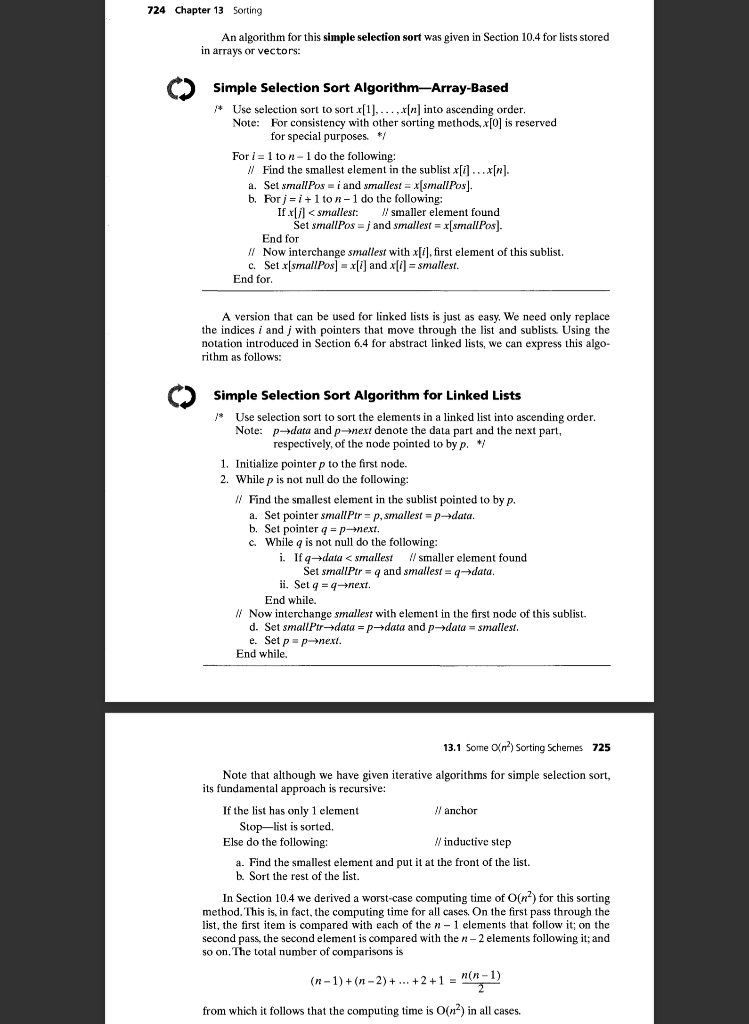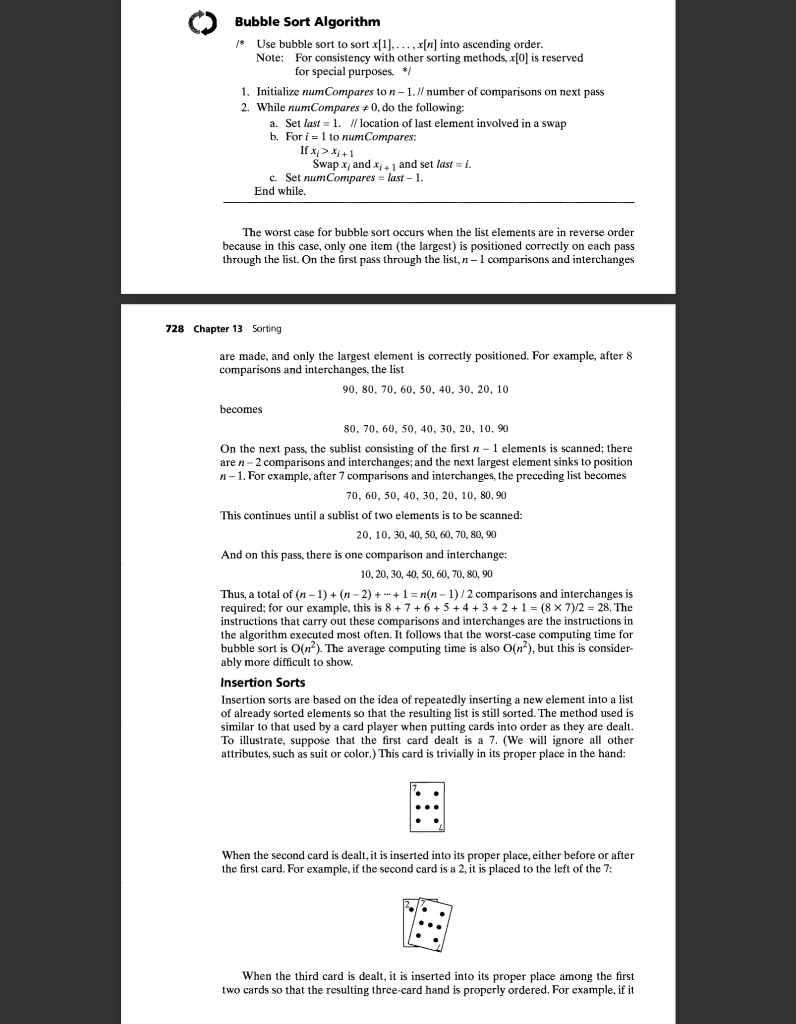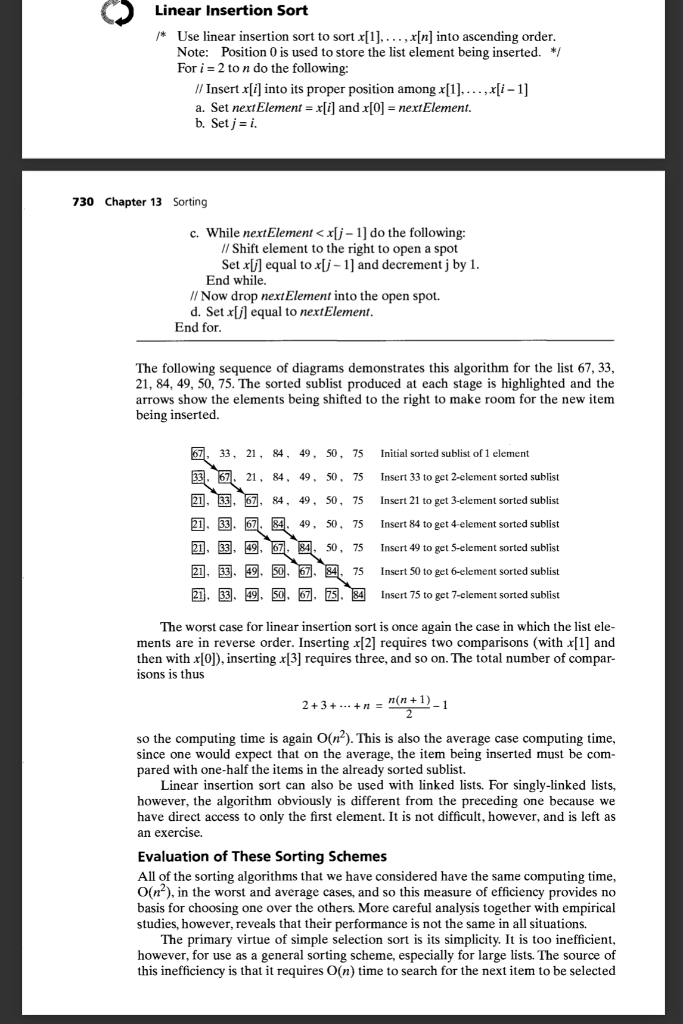Question
You are asked to implement the 3 methods that are described in Section 13.1. These methods are: optimized bubble sort insertion sort selection sort Build





You are asked to implement the 3 methods that are described in Section 13.1. These methods are: optimized bubble sort insertion sort selection sort Build one header file and its corresponding implementation file that implements these methods. Write a tester file that test these methods on vectors of different capacity with integer elements generated randomly and compare their efficiency based on the size of the data. In order the verify that the data is correctly sorted, define the function isSorted that test if the returned vector by the different functions that implement the sorting methods described above.
The programming Language is C++
Concerning vectors simply google vectors c++ to get more familiar with it.
13.1 Some O(n?) Sorting Schemes We begin our discussion of sorting algorithms by considering one simple sorting scheme from each of the three categories listed in the introduction: selection, exchange, and insertion. These are sorting methods that are typically studied in intro- ductory programming courses because they are relatively easy to understand and not because they are the best. Also, it should be noted that, for simplicity, we are assuming that the lists to be sorted have elements for which the relational operators ( Xi+1 Swap x; and Xi+ and set last=1 c. Set numCompares = last-1. End while. The worst case for bubble sort occurs when the list elements are in reverse order because in this case, only one item (the largest) is positioned correctly on each pass through the list. On the first pass through the list, n - 1 comparisons and interchanges 728 Chapter 13 Sorting are made, and only the largest element is correctly positioned. For example, after 8 comparisons and interchanges, the list 90, 80, 70, 60, 50, 40, 30, 20, 10 becomes 80, 70, 60, 50, 40, 30, 20, 10.90 On the next pass, the sublist consisting of the first n - 1 elements is scanned; there are n-2 comparisons and intercha the next largest element sinks to position n-1. For example, after 7 comparisons and interchanges, the preceding list becomes 70, 60, 50, 40, 30, 20, 10, 80, 90 This continues until a sublist of two elements is to be scanned: 20, 10, 30, 40, 50, 60, 70, 80, 90 And on this pass, there is one comparison and interchange: 10, 20, 30, 40, 50, 60, 70, 80, 90 Thus, a total of (n-1)+ (n - 2) + - +1 =n(n-1)/2 comparisons and interchanges is required; for our example, this is 8 + 7 + 6 +5+4 + 3 + 2 + 1 = (8 x 7)/2 = 28. The instructions that carry out these comparisons and interchanges are the instructions in the algorithm executed most often. It follows that the worst-case computing time for bubble sort is O(n?). The average computing time is also O(n), but this is consider- ably more difficult to show. Insertion Sorts Insertion sorts are based on the idea of repeatedly inserting a new element into a list of already sorted elements so that the resulting list is still sorted. The method used is similar to that used by a card player when putting cards into order as they are dealt. To illustrate, suppose that the first card dealt is a 7. (We will ignore all other attributes, such as suit or color.) This card is trivially in its proper place in the hand: When the second card is dealt, it is inserted into its proper place, either before or after the first card. For example, if the second card is a 2, it is placed to the left of the 7: When the third card is dealt, it is inserted into its proper place among the first two cards so that the resulting three-card hand is properly ordered. For example, if it Linear Insertion Sort * Use linear insertion sort to sort x[1],...,x[n] into ascending order. Note: Position is used to store the list element being inserted. */ For i = 2 to n do the following: // Insert x[i] into its proper position among x[1],...,x[i-1] a. Set nextElement = x[i] and x[0] = nextElement. b. Set j =i. 730 Chapter 13 Sorting c. While nextElementStep by Step Solution
There are 3 Steps involved in it
Step: 1

Get Instant Access to Expert-Tailored Solutions
See step-by-step solutions with expert insights and AI powered tools for academic success
Step: 2

Step: 3

Ace Your Homework with AI
Get the answers you need in no time with our AI-driven, step-by-step assistance
Get Started


